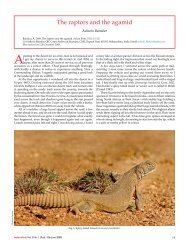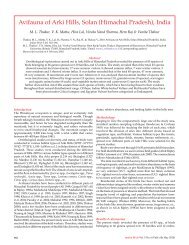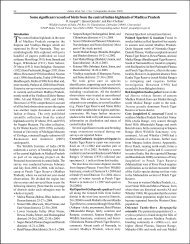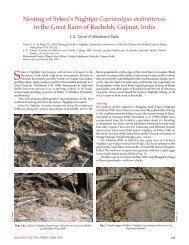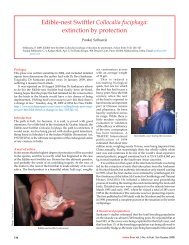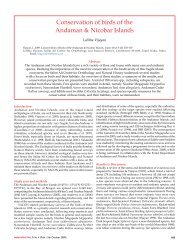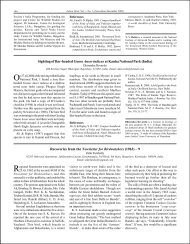Black-necked Crane Grus nigricollis (Local Name ... - Indian Birds
Black-necked Crane Grus nigricollis (Local Name ... - Indian Birds
Black-necked Crane Grus nigricollis (Local Name ... - Indian Birds
- No tags were found...
You also want an ePaper? Increase the reach of your titles
YUMPU automatically turns print PDFs into web optimized ePapers that Google loves.
<strong>Indian</strong> <strong>Birds</strong> Vol. 1 No. 5 (September-October 2005) 109<strong>Indian</strong> <strong>Birds</strong> Vol. 1 No. 5 (September-October 2005)<strong>Black</strong>-<strong>necked</strong> <strong>Crane</strong><strong>Grus</strong> <strong>nigricollis</strong>(<strong>Local</strong> <strong>Name</strong>: Cha Thungthung)We saw eight adults andtwo chicks (2005 season)at Hanle (Mahe andTsokar). What can abirder / wildlifephotographer tell aboutthis magnificent bird?Words cannot express theawe and wonder that onefeels seeing it walkmajestically through thecold marshes of Ladakh.One cannot imagine awilderness without thiscrane. It is the heart andsoul of avian life inLadakh. Yet its survivalhangs by a thin line. Thelocal dogs (TibetanMastiff) are the greatestthreat to the cranes’ eggsand young ones. Evenadults are taken. Fourcrane nests weredecimated at Hanle itselfby these dogs this year(2005).
<strong>Indian</strong> <strong>Birds</strong> Vol. 1 No. 5 (September-October 2005) 111Hill Pigeon Columbia rupestris (<strong>Local</strong> <strong>Name</strong>: Angoa, Mukron)We found this bold bird almost everywhere that we traveled in Ladakh, atLeh, Mahe, Hanle, Tso-moriri and Tso-kar. Also at the Shey and Tiksemarshes. They fed on gravel and also near restaurants. On the highways atLeh they were seen feeding on left over food. They look bulky and verysturdy to survive the harsh climatic conditions of Ladakh. Their survivalskill were great and we found them feeding on seeds and partially digestededibles from the dung of kiang. We even found them feeding on theundigested food from the stomachs of dead kiangs at Hanle, which wereripped open by local dogs and birds of prey.Little Owl Athena noctua (<strong>Local</strong> <strong>Name</strong>: Ugpa)At Tso-kar, a pair had nested inside a wolf-trap. These are designed byPashmina tribals to trap and kill wolves, which prey on their Pashminagoats. There were four fully grown chicks, which never allowed us tophotograph them; they hid themselves well inside the stony construction ofthe wolf trap. Tso-kar did not have much water, as we expected, but hadlots of voles, which are part of the owl’s prey. The adult sat under theshade of a boulder and allowed us to take a few pictures. The sun light wasvery harsh for photography and we left the area happy with the knowledgethat the pair had bred successfully and the young were in good condition.Horned Lark Eremophila alpestris (Loal <strong>Name</strong>: Rizit)Horned Larks are among the commonest birds in Ladakh. We found them veryactive even after sunset. At Tso-moriri, where there is enough sunlight even at20:00hrs, these birds fed on grass seeds and tubers even as late as 22:00hrs. Theirfledged young (top photo) are beautifully marked in buff, black and brown on theback. July being almost the end of their breeding season, we found manyjuveniles flying around adults and feeding on grass seeds and tubers. They wereeven digging for maggots in the marshes. (Middle: Female. Bottom: Male.)
112<strong>Indian</strong> <strong>Birds</strong> Vol. 1 No. 5 (September-October 2005)Citrine Wagtail Motacilla citreola (<strong>Local</strong> <strong>Name</strong>: Sterzi)At Tikse marshes we found more than ten pairs of these birds breeding.Some were feeding fledged young while others had young in nests. Allthe nests were placed on the ground inside thick grass. Plenty of flymaggots were present in the marshes and these birds feasted on them.They arrived at their nests, with beak-fuls of maggots, every 5-10minutes. A pair of Hume’s Whitethroat Sylvia althaea was also nestingfive feet from a pair of wagtails. When adults of both the species arrivedin the nesting area, with prey for their young, they tried to aggressivelychase each other out of the nesting area. There were many grass-cuttersin that area and the birds were seldom shy of them. We found a fewpairs nesting at Shey marshes as well.<strong>Black</strong>-billed Magpie Pica pica (<strong>Local</strong> <strong>Name</strong>: Chiatsaga, Katang-putit)Found all over Leh and surrounding areas. They seem to fill in for crows in Ladakh, virtually ruling the urban sky. In the Leh area we found a fewactive nests around the city on trees, which David Sonam said had been nests of Pond Herons Ardeola grayii and were usurped by these birds. Theywere seen around garbage dumps and marshy areas. In marshy areas they dug for edible items. Some hung around roadside restaurants for easy meals.By July we found most adults with fully-fledged young and the adults were teaching them to dig the loose soil for food. At higher elevations like Tsomoririand Hanle we did not see this bird at all.Desert Wheatear Oenanthedeserti oreophila(<strong>Local</strong> <strong>Name</strong>: Chiu-logzi)At Hanle we saw at least fourpairs of these birds with youngones. They had nested in creviceson the hills. Many differentkinds of flies were breeding inhuge numbers in the marshes andtheir maggots were harvested bythe adults. It was amazing to seethese small birds withstanding theharsh climatic conditions ofLadakh. Males were clothed inbreeding plumage. Quite tolerantof humans – one male came asclose as four feet from me to digout a maggot. Their beaks arefantastically designed for diggingloose soil for insect larvae.(Left: Male. Right: Juvenile.)



